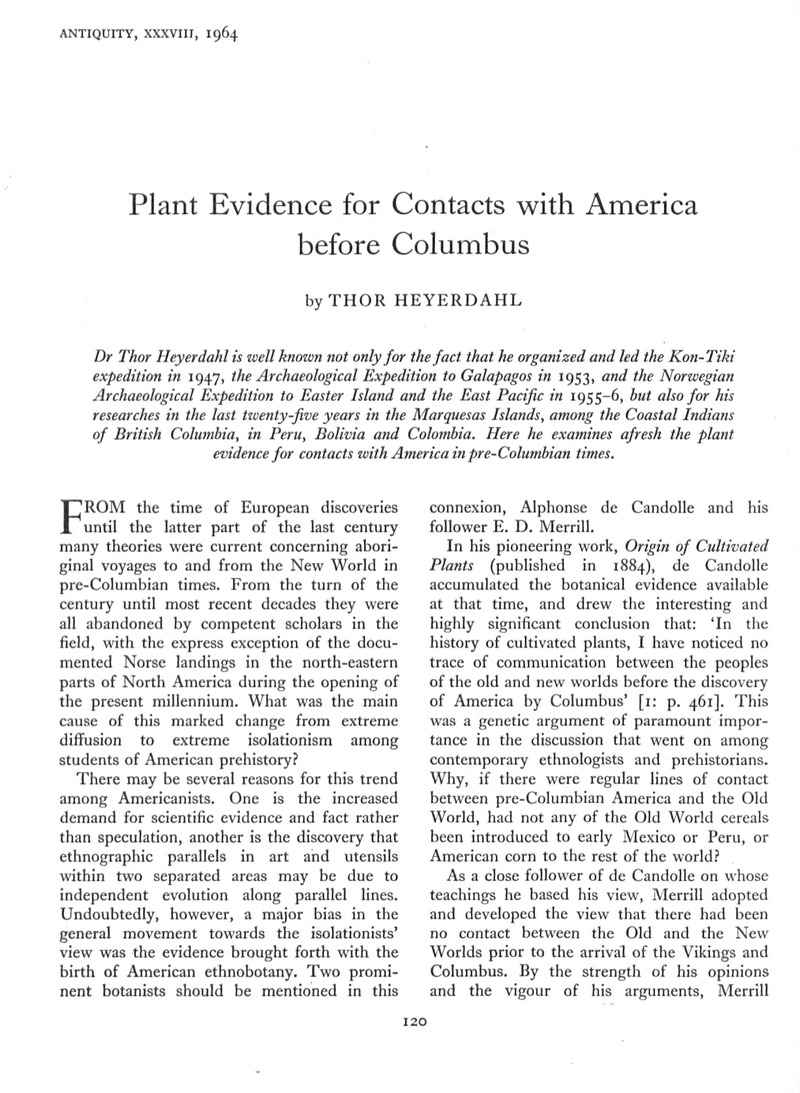Article contents
Plant Evidence for Contacts with America before Columbus
Published online by Cambridge University Press: 02 January 2015
Abstract

- Type
- Research Article
- Information
- Copyright
- Copyright © Antiquity Publications Ltd. 1964
Footnotes
Dr Thor Heyerdahl is well known not only for the fact that he organized and led the Kon-Tiki expedition in 1947, the Archaeological Expedition to Galapagos in 1953, and the Norwegian Archaeological Expedition to Easter Island and the East Pacific in 1955–6, but also for his researches in the last twenty-five years in the Marquesas Islands, among the Coastal Indians of British Columbia, in Peru, Bolivia and Colombia. Here he examines afresh the plant evidence for contacts with America in pre-Columbian times.
References
[1] A. de Candolle, Origin of Cultivated Plants (London, 1884).
[2] E. D. Merrill, ‘Domesticated plants in relation to the diffusion of culture’, Early Man (Philadelphia, 1937), 282.
[3] E. D. Merrill, ‘Merrilleana: A selection from the general writings of Elmer Drew Merrill’, Chronica Botanica, x, nos. 3-4, 1946, 344.
[4] E. D. Merrill, The Botany of Cook’s Voyages and its Unexpected Significance in Relation to Anthropology, Biogeography and History (Waltham, Mass., 1954).
[5] H. B. Guppy, Observations of a Naturalist in the Pacific Between 1896 and 1899, vol. II (London, 1906).
[6] E. Nordenskiold, ‘Origin of the Indian Civilization in South America’, Comp. Ethnogr. Stud., IX (Gothenburg, 1931), 269.
[7] P. H. Buck, Vikings of the Sunrise (New York, 1938), 315.
[8] P. H. Buck, ‘An Introduction to Polynesian Anthropology’, B. P. Bishop Mus. Bull. 187 (Honolulu, 1945).
[9] A. J. Eames and J. St John, ‘The Botanical Identity of the Hawaiian Ipu Nui or Large Gourd’, Amer. Jour. Bot., xxx, no. 3, 1943, 256.
[10] E. D. Merrill, ‘Observations on Cultivated Plants with Reference to Certain American Problems’, Ceiba, I, no. 1 (Tegucigalpa, Honduras, 1950), 9.
[11] J. B. Hutchinson, R. A. Silow and S. G. Stephens, The Evolution of Gossypium and the Differentiation of the Cultivated Cottons (London, New York and Toronto, 1947), 79.
[12] C. O. Sauer, ‘Cultivated Plants of South and Central America’, Handbook of South American Indians, vol. VI (Washington, D.C., 1950).
[13] G. F. Carter, ‘Plant Evidence for Early Contacts with America’, South Western Jour. Anthrop., VI, no. 2 (Albuquerque, N.M., 1950).
[14] C. Skottsberg, ‘Le peuplement des îles pacifiques du Chili’, Soc. de Biogéogr., IV (Paris, 1934), 278.
[15] C. Skottsberg, ‘Derivation of the Flora and Fauna of Juan Fernandez and Easter Island’, The Natural History of Juan Fernandez and Easter Island (Uppsala 1920-56), vol. I, pp. 193-438 (esp. 407, 412).
[16] C. Skottsberg, ‘Påskön’. Göteborge Handelsoch Sjofartstidning, 7th October, 1957 (Gothenburg).
[17] W. J. Thomson, Te Pito the Henua or Easter Island (Washington D.C., 1889), 456.
[18] M. S. Bertoni, ‘Essai d’une monographie du genre ananas’, Anal. Ci. Paraquaoys, 11, no. 4 (Asuncion, 1919), 280.
[19] F. B. H. Brown, ‘Flora of Southeastern Polynesia, I: Monocotyledons’, B. P. Bishop Mus. Bull., 84 (Honolulu, 1931).
[20] O. Degener, Ferns and Flowering Plants of Hawaii National Park (Honolulu, 1930), 88.
[21] E. H. Bryan Jr., Hawaiian Nature Notes (Honolulu, 1935), 67.
[22] W. Hillebrand, Flora of the Hawaiian Islands (Heidelberg, 1888), 14.
[23] D. Prain, ‘An account of the genus Argemone’, Jour. Bot., XXXIII, 1895, 325.
[24] F. Fedde, ‘Papaveraceae-Hypecoidae et Papaveraceae-Papaveroideae’, Das Pflanzenreich, H. 49 (Leipzig, 1909), 280.
[25] J. F. G. Stokes, ‘Spaniards and the sweet potato in Hawaii and Hawaiian American contacts’, Amer. Anthrop., XXXIV, no. 4, 599.
[26] E. Yacovleff and F. L. Herrera, ‘El mundo vegetal de los antiguos peruanos’, Rev. Mus. Nac., IV, no. 1 (Lima, 1935).
[27] F. B. H. Brown, Flora of Southeastern Polynesia, III: Dicotyledons (Honolulu, 1935).
[28] J. G. Baker, ‘A synopsis of the genera and species of Museae’, Ann. of Bot., VII (London, 1893), 192.
[29] O. F. Cook, ‘Food Plants of Ancient America’, Ann. Rept. Smiths. Inst. (Washington D.C., 1903).
[30] R. T. Clausen, ‘A Botanical Study of the Yam Beans (Pachyrrhizus)’, Cornell Univ. Mem. 264 (Ithaca, New York, 1944), 29.
[31] E. Yacovleff and F. L. Herrera, ‘El mundo vegetal de los antiguos peruanos’, Rev. Mus. Nac, III, no. 3 (Lima, 1934).
[32] J. H. Steward, ‘The Comparative Ethnology of South American Indians’, Handbook of South American Indians, vol. v (Washington D.C., 1949).
[33] M. W. Jakeman, ‘The XXIX International Congress of Americanists’, Bull. Brigham Young. Univ., March 1950.
[34] O. F. Cook and R. C. Cook, ‘The Maho, or Managua, as a Trans-Pacific Plant’, Jour. Wash. Acad. Sci., VIII, 1918.
[35] E. D. Merrill, ‘Comments on Cook’s Theory as to the American Origin and Prehistoric Polynesian Distribution of certain economic Plants, especially Hibiscus tiliaceus Linnaeus’, Philippine Jour. Sci., XVII (Manila, 1920), 195.
[36] F. Körnicke, ‘Uber die Heimath unserer Gartenbohne Phaseolus vulgaris’, Verh. Naturhist. Ver. Preuss. Rheinlande, etc. (Bonn, 1885), 136.
[37] L. Wittmack, ‘Uber Bohnen aus altperuanischen Grabern’, Sitzber. bot. Ver. d. Prov., XXI (Brandenburg, 1880), 176.
[38] L. Wittmack, ‘Unsere jetzige Kenntnis vorgeschichtlicher Samen’, Ber. Deutsche Bot. Ges., IV (Berlin, 1886). ‘Die Heimath der Bohnen und der Kürbisse’, Ber. Deutsche Bot. Ges., VI, no. 8 (Berlin, 1888).
[39] C. R. Stonor and E. Anderson, ‘Maize among the Hill Peoples of Assam’, Ann. Missouri Bot. Gard., XXXVI, no. 3, 1949, 392.
[40] T. W. Whitaker and J. B. Bird, ‘Identification and Significance of the Cucurbit Materials from Huaca Prieta, Peru’, Amer. Mus. Noviates, no. 1426 (New York, 1949).
- 3
- Cited by




